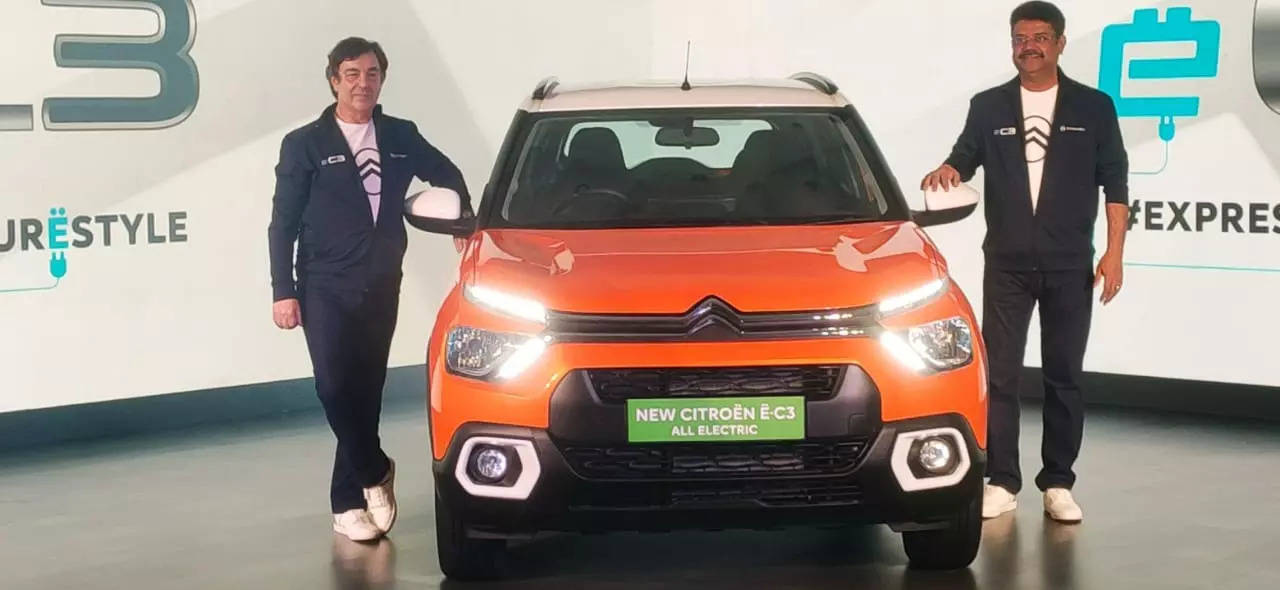
Chennai: In the Indian passenger vehicle market of over 3 million units, Citroen is in its initial phase with sales of about 1,400 units a month. It’s a tougher task to gain a significant share in the traditional ICE vehicle market than in the emerging EV industry. Citroen India is strategizing to do what is relatively less challenging.
And that is what it wants to do starting with e-C3, the EV version of its B-segment SUV-styled petrol hatchback launched a little over 6 months ago. And in this strategy, Citroen India looks to woo the fleet segment as the volume driver, at least in the initial phase.
“Purely from cost economics, the fleet customers find EVs to make a lot of sense in taxation, running cost etc. There are also many end-customers who ask for vehicles which are green,” Saurabh Vatsa, Head, Citroen India, told ETAuto. Fleet customers are learnt to be looking at some “significant numbers”.
The India engineering team also took feedback from fleet customers while developing the e-C3, to understand their ‘pain points’. Vatsa said that unlike the usual trend of despecced variants for fleet segment, there’s a growing demand for higher variants of EVs in the fleet segment.
The e-C3 is powered by a 29.2 kWh battery pack, which Citroen claims can be fast charged throughout its life without any significant deterioration usually caused by DC charging. The ARAI-certified driving range for the vehicle is 320 km.
The naturally cooled battery pack is expected to take 57 minutes for a 10-80% charging cycle in a DC charger, and 10.5 hours in a 15-amp household plug point. The LFP (Lithium Iron Phosphate) battery pack is expected to have 2,500 to 3,000 charging cycles.
As the EV trend in India grows, vehicles with the tailpipe emission-free technology could contribute to around 10% of overall passenger vehicle (PV) sales in the country by 2025/26. It is here that Stellantis sees a better chance to be a significant player than in the traditional market.
“What we believe is that strategically with the launch of e-C3 in India, from a ‘newcomer’ we’ll become one of the key first players. That’s why it is so important,” Roland Bouchara, CEO & MD, Stellantis-India, told ETAuto..
The e-C3, expected to sport an entry price tag of around INR 10 lakh, will have the Tata Tiago EV as the closest competitor. The Tata electric hatchback, which was introduced with an introductory entry-level price tag of INR 8.49 lakh for the initial 10,000 bookings which got extended to 20,000 units, is expected to see an upward price revision soon.
Hybrid is not part of electrification strategy: As it gets ready to embark on its electrification journey in India, Citroen doesn’t see itself playing in the hybrid vehicle space. “Hybrids don’t make sense from a tax efficiency perspective for the consumers. And if there’s no consumer demand, obviously it doesn’t make sense for us to be there,” Vatsa said.
Globally, Stellantis has hybrids in its portfolio. The fourth largest passenger vehicle maker in the global industry has set a target of 2038 to achieve carbon neutrality. By 2030, the Group’s plan is to achieve 100% of its sales in Europe, and 50% of sales in the US from BEVs (Battery Electric Vehicle).
India, a key technology development base: During 2021-25, Stellantis plans to invest over Euro 30 billion in electrification software. Much of the software engineering will be done in its India software engineering centre in Hyderabad. The Group plans to have 4 new full BEV platforms, and 3 new technology platforms for advanced computing, smart cockpit, and autonomous driving.
By 2030, the Indian PV market is expected to see 15% of its volumes from EVs. Whether Citroen becomes a “key” player there, the consumer will give the verdict. Citroen India wants to reach as many of them as possible by expanding its sales network from 30 outlets last year, to 75 this year. The C3 platform will spawn a third model, an ICE vehicle, later this year.
Also Read:
















